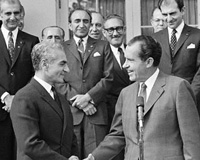After meeting with Soviet leaders in Moscow, then U.S. president Richard Nixon, along with National Security Advisor Henry Kissinger arrived in Tehran, May 31, 1972 and met with the Shah and friendly negotiations were conducted. Evidence proved the unprecedented expansion of friendly relations between the Shah and the United States. During the meetings...
After meeting with Soviet leaders in Moscow, then U.S. president Richard Nixon, along with National Security Advisor Henry Kissinger arrived in Tehran, May 31, 1972 and met with the Shah and friendly negotiations were conducted. Evidence proved the unprecedented expansion of friendly relations between the Shah and the United States. During the meetings, Richard Nixon praised the leadership of the Shah and his role in strengthening and stabilizing the Persian Gulf region security, and promised "that he may buy any non atomic weapons he wishes from the United States.” Nixon’s favorable promise provided a good opportunity for the Shah to purchase the latest military equipment and to make true the Shah’s golden dreams. In the meantime, the U.S. Ministry of Defense and State Department were ordered by the president "to refrain from the process of monitoring arms sales [to Iran]". At the same time, the policy of selling weapons to Iran “was a source of wealth for arms producers in the U.S. and three sections responsible for preparing military equipment and also for Defense Security Assistance Organization”. At the same time Henry Kissinger advised the American Foreign and Defense Ministers to let “Iran purchase its military equipment according to his own request. Despite strict orders from Nixon, Pentagon warned that "the United States should not commit itself to sell F-14 and F-15 bombs to Iran and not to provide it with laser led bombs", but Nixon and Kissinger were heedless of these warnings.
Thus it became possible for the king to reach an agreement with the Grumman company to buy Tom Kat F-14 fighter jets that "were the most complex and expensive fighter jets at that time in the world". During 1972-1977, great orders of military equipment were sent by the Shah to U. S. arms factories and the U.S. arms sales to the king during this period amounted to more than 2/16 billion dollars. Consequently, Iran’s military budget raised from 1,4 billion dollars in 1972 to 9,4 billion dollars in 1977 which meant " 680 percent increase."
According to statistics, military budget of Iran "was 40 percent of the whole budget." The growing process of gun purchase increased again with the rise in the oil price to four times in 1973. And Iran’s income from oil amounted to 20 billion dollars a year. In fact, both "Nixon and Kissinger’s explanation in giving full military powers to the king was the U.S. ultimate need to have a powerful local force to protect U.S. interests in the Persian Gulf. In other words, they saw "the interests of both U.S. and Iran, in line with each other, and Henry Kissinger “believed Shah was the" rarest of leaders and an indisputable ally whose understanding of the world strengthened our viewpoints of world. " So the king eagerly ordered a long list of U.S. military equipment and further to his orders for F-14 fighter jets, he sought to buy more advanced F-16 and F-18 jets from military companies. The project was a "part of the 50 billion dollar business plan should carried out between the two countries between 1975 and 1980." Meanwhile, Henry Kissinger stated that the U. S. government was ready to meet the military needs of the king and reminded the critics that "the Shah was a valid customer and good at settling his accounts. Although King was successful during 1972-1978 to receive substantial amounts of military equipment including requested 80 F-14 Tom aircraft from the U.S., the storm of revolution did not leave him more chance to continue the purchase of military arms.
https://iichs.ir/vdcb.0b8urhbs0e4pr.html
iichs.ir/vdcb.0b8urhbs0e4pr.html
